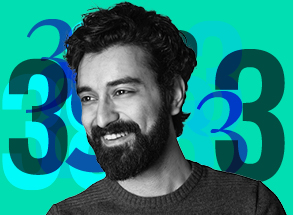Invest to make more of your money
We look at why investing is one of the five key building blocks towards a financially secure future.

Important notes
This article isn’t personal advice. If you’re not sure whether an investment is right for you please seek advice. If you choose to invest the value of your investment will rise and fall, so you could get back less than you put in.
We’ve learnt throughout the 5 to Thrive series that, if we want to have a financially secure future, we need to think about the long-term not just the short-term. That means not spending all of our hard-earned income straight away and making sure we’ve saved some of it in our rainy-day savings pot and retirement pot.
Although both of those are key to building a financially resilient future, there’s still one more thing you can add to improve your financial resilience – an investment strategy.
This article isn’t personal advice, it’s a guide to how investing could help you build your wealth over the long term. If you’re not sure what to do, please ask for financial advice.
Is investing for everyone?
Before the pandemic, it often felt that in the investing game the table was reserved for wealthy city boys. More recently, investing has taken hold more widely.
In fact, the average age of a person using the HL platform has dropped from 54 in 2012 to 40 in 2021, showing a new engagement from younger generations.
It’s important to draw a distinction between short term trading and long-term investing here. Traders try to beat the market to make a fast buck and, as a result, they take big risks. Investors have a long-term approach and are interested in building a sensible, diversified portfolio designed to help them get rich slow. That's why investing is one of the pillars of financial resilience.
It’s worth saying from the outset that investing isn’t for everyone. It depends on what stage you’re at with the other building blocks for financial resilience.
Investing should be for the long term. And when we say long term, we mean at least 5 years. If you’re saving for any short-term goals you plan to reach within the next 5 years, you should keep your savings as cash.
For your short-term goals, you could think about using a cash savings platform like HL’s Active Savings service to help boost your cash returns. Choose from a range of easy access and fixed term products from different banks and building societies all in one online account. There's no hassle of filling in forms or additional identity checks when opening, closing and transferring between savings products.
Why invest?
Put in just a few words, we invest to make our money work that little bit harder for us.
Although cash savings won’t fall in value, they’re not risk free. Cash can struggle to keep up with inflation, so you could lose money in real terms over the longer term.
Inflation measures how much the price for goods and services has gone up over time.
When there’s inflation in an economy, the value of money decreases because people would need to spend more to buy the same products. Put simply, £1 would get you further this year than £1 would in ten years’ time.
Currently, 14.1% of British households don't hold any investments, despite having at least six months' worth of essential spending as cash.
Compare who in the UK is and isn’t investing
Wherever you put your money, you'll need to balance the risk with the potential reward. All investments carry a degree of risk, some more than others. Unlike the security of cash, all investments can fall as well as rise in value so you could get back less than you invest.
With that in mind, the thought of losing some of our hard-earned money is enough to put some of us off even considering investing. So, why take the risk?
You might see the stock market as being high risk however, it's usually only the days when the market falls that makes the headlines. In reality, investing can offer an opportunity to grow your wealth and beat inflation over the long term.
But investing isn’t right for everyone, and there are some risk involved. We think you should only consider investing once your short-term debts are paid, you can afford your regular bills, your emergency cash savings pot has at least three to six months’ worth of essential expenditure and you’re making sufficient pension contributions if you’re still working. When you have those boxes checked, you can think about investing.
It’s also easier to build these habits than you might think. Investing in smaller chunks on a monthly basis not only means you’re not paying out one large sum, but also means you’ve got a better chance of riding out the ups and downs of the market. At HL, you can start investing on a monthly basis from £25.
We all know stock markets can be volatile. By drip-feeding into the market in smaller amounts over time, you spread your money across different market conditions. Sometimes you’ll buy at a higher price and other times it could be lower – but you won’t have to worry about the timing. Over time, these ups and downs tend to average out. It’s called ‘pound-cost averaging'.
Compounding – your most powerful investing tool
Starting out with investing
Most people don’t have the time, resources or experience to be full-time stock pickers.
If you’re looking for an easy and convenient way to invest, funds are a great place to start. A fund is an investment that pools together money from lots of individual investors. The fund’s manager then invests the money in a range of different investments on your behalf. Each investor is issued units representing their portion of the holdings. They’re managed and run by a professional, so you benefit from their expertise, knowledge and research. Whether you’re a novice or a seasoned investor, they can be a great foundation to a portfolio.
Investing in funds means your money is spread across different investments. If the value of one investment held within the fund goes down, other investments could stay the same, or go up. This helps spread the risk and smooth those ups and downs, so the total value of the fund isn’t affected as much by volatility compared to individual shares.
If you bought shares in 50 or 100 different companies yourself, you’d see a big chunk of your money get eaten up by dealing fees and other costs. In a fund, these costs are shared with the other investors.
Each fund will have its own set of goals, and the fund manager will select investments to hold within the fund to reach those objectives. You’ll need to choose funds that align with your own.
Investing in funds isn’t right for everyone. Remember, investments go down as well as up in value, so you could still get less than you put in.
Our guide to investing in funds
Where could you hold your investments?
If you’ve decided you’re ready to start investing, you’ll need to think about where you want to hold your investments. You’ll need to choose an investment account that works best for your personal situation.
An investment account is a bit like a basket.
It isn’t an investment in its own right. It’s where you hold any investments, like funds or shares which you choose to purchase.
You can have more than one type of account, and each will have pros and cons depending on your goals. For example, some accounts have higher charges than others and some have tax-efficient benefits. Watch out for any restrictions on the amount you can put in each year, as well as restrictions when you take money out. Remember tax rules change and benefits depend on individual circumstances.
To find an account that’s right for you, you could try using our compare accounts tool.
Investing checklist
- Make sure you’ve got the previous 5 to Thrive steps covered.
- Only invest money you don’t need within the next 5 years – you need to think long term when you invest.
- Check you have a good level of diversification.
- Make sure your portfolio matches your attitude to risk.
- Review your portfolio every 6 months to a year to make sure it’s on track and matches your goals and attitude to risk.
Important notes
This article isn’t personal advice. If you’re not sure whether an investment is right for you please seek advice. If you choose to invest the value of your investment will rise and fall, so you could get back less than you put in.




